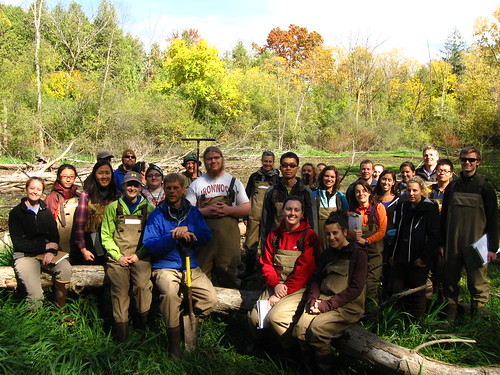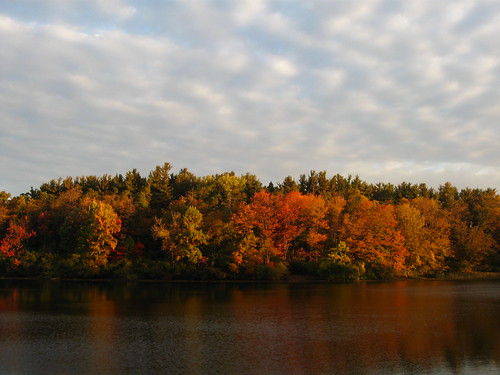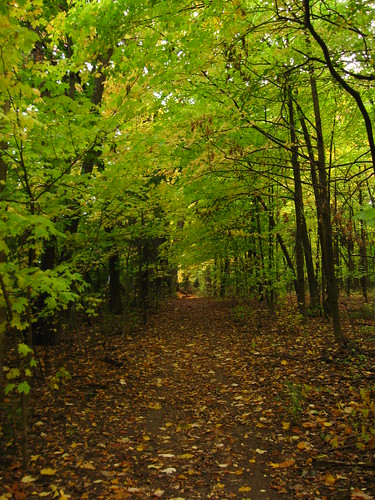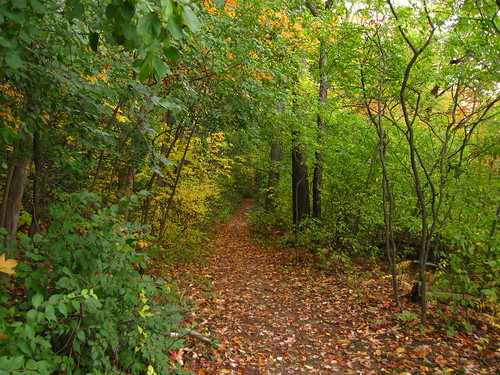A scattering, skittering, and pattering sound on the roof this morning as I woke up meant hail. And, yes, there was a lot of small hailstones that were hitting the cabin and building up along any nooks and crannies along the ground.
The winds had picked up a bucket and was pushing it around the yard, so into the barn that went.
Nothing other than some small branches down on the road out of the forest, at least at this point. Fingers remained crossed that it won't get more serious.
Use of the Forest
Public use of Saginaw Forest is encouraged. Rules for the public's use include (but are not limited to):
- No parking in front of the access gate.
- Public use hours are from 6am to 6pm only; no camping on the site!
- No vehicles or bicycles are permitted on the site except those for approved research and teaching use (bike parking available at the main gate).
- Dogs with owners are welcome to visit, but they must be on a leash. (Also see here.)
- Dog owners must carry out all pet waste; please bring your own doggie bag to do so.
- No cutting or collecting of plant material; no hunting or harming vertebrates (this includes no fishing).
- No smoking.
Tuesday, October 30, 2012
Monday, October 29, 2012
Intense winds (and potential for snow in the morning)
All of today and throughout tomorrow, there has been and will continue to be severe wind, mostly from the north, thanks to Hurricane Sandy hitting the East Coast. This is potentially worrisome, because the forest does not encounter very many winds from the north (let alone gusts), so there could be some trees down tomorrow. Luckily, the north of the cabin is the lawn, so it's unlikely that the wind will topple a tree onto the cabin from that direction. Still... the power could also go out.
In addition to all this, there is a possibility for snow!
Fingers crossed that nothing bad happens tonight, tomorrow, or for the rest of this storm.
In addition to all this, there is a possibility for snow!
Fingers crossed that nothing bad happens tonight, tomorrow, or for the rest of this storm.
Friday, October 26, 2012
Girl Scouts in Saginaw Forest
Last weekend, there were a number of girl scouts in Saginaw Forest. The following is from Erin Lane, from SNRE's Teaching and Inspiring Environmental Stewardship (TIES) program:
Two summers ago, the TIES program collaborated with the WISE (Women in Science and Engineering) program, and brought a number of female high school students to the forest to learn field research techniques. Hopefully, the TIES program will continue to be able to make use of the property as a teaching space for women and girls of all ages.
Thanks again to Erin and the U-M undergraduates who came out to make this even a great one for both the kids and parents who came out last weekend. It was fun to watch an enthusiastic group of kids, excited parents, and capable group coordinators.
The name of the event on October 21st was "Saginaw Forest Hiker", and it was an event in which girl scouts could practice hiking skills and play outdoor games to earn their "Hiker" Skill-Building Badge.
This was the first event that TIES has held for girl scouts at Saginaw Forest - the feedback from parents, scouts and troop leaders was outstanding! Therefore, we will aim to offer the event again next fall. The troops that attended were numbers 40280 and 60026. In addition, there was a "Juliette" (that's a girl scout term for a participant who does not belong to a troop) who also attended the event.
One of the parents sent a picture of her daughter, Audrey Hertz (she was the "Juliette"), who had just found a snake in the fallen leaves. The person in the photo holding the snake is a U-M undergrad who works for TIES, Veronica Kincaid.
Two summers ago, the TIES program collaborated with the WISE (Women in Science and Engineering) program, and brought a number of female high school students to the forest to learn field research techniques. Hopefully, the TIES program will continue to be able to make use of the property as a teaching space for women and girls of all ages.
Thanks again to Erin and the U-M undergraduates who came out to make this even a great one for both the kids and parents who came out last weekend. It was fun to watch an enthusiastic group of kids, excited parents, and capable group coordinators.
Massive leaf fall; more yet to come
I guess all the gusty winds on Thursday really helped shed leaves from branches, because the trees look far more barren than they did on Wednesday and my lawn is suddenly filled with lots of dried leaves (mostly oak it seems). The raking will likely continue for a few more weeks, though, since there are still a few trees that are cloaked with yellowing leaves. Soon, too, the buckthorn and the honeysuckle will be the only deciduous trees/shrubs that will have green leaves, making them a lot more easy to spot for potential removal. (In the spring, these plants are also one of the first woody plants to leaf out.)
Fall Photos
Some photos of the changing season:

The poison ivy are about to lose their leaves. (Still bad to touch them, though.)

The maples near the gate are slowly moving toward their color shifts.
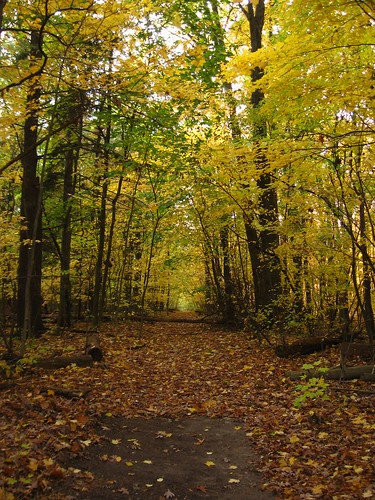
I decided to quit my raking of the path after I realized how much work was going to be falling from branches in the coming weeks. Still: they need to be raked so that they don't turn into muddy lanes come the spring.

Almost stepped on this guy as I was going back into the cabin. He wasn't any wider than my finger!

The poison ivy are about to lose their leaves. (Still bad to touch them, though.)

The maples near the gate are slowly moving toward their color shifts.

I decided to quit my raking of the path after I realized how much work was going to be falling from branches in the coming weeks. Still: they need to be raked so that they don't turn into muddy lanes come the spring.

Almost stepped on this guy as I was going back into the cabin. He wasn't any wider than my finger!
Monday, October 22, 2012
"No parking" has long been difficult for people to understand
Yesterday, I encountered a few vehicles that were parked at the gate, despite the plain signage that says that it is not legal to park there. For example, there was this SUV that was parked right in front of the "No parking" sign (just in case you had a difficult time to recognize the sign, what with all the colorful foliage, I've highlighted the sign):
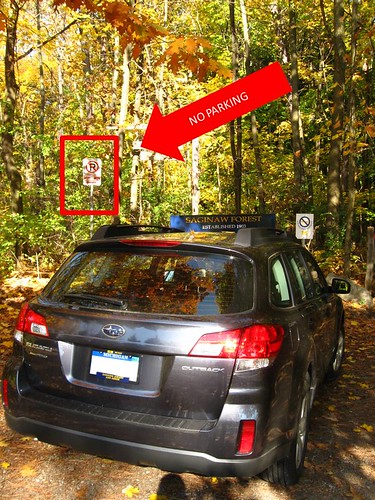
What's more, I decided to look up how many of the previous caretakers kvetched about no parking.
In 2007, in 1991, in 1989 (twice), and in 1987 In other words, it's been a consistent problem.
And I'm sure that the previous caretakers didn't note every single instance of having to report a vehicle (and not every caretaker wrote in the log book, either). I think that the number of people parking at the gate has diminished, but it is still higher than what would be the case if people followed the law.

What's more, I decided to look up how many of the previous caretakers kvetched about no parking.
In 2007, in 1991, in 1989 (twice), and in 1987 In other words, it's been a consistent problem.
And I'm sure that the previous caretakers didn't note every single instance of having to report a vehicle (and not every caretaker wrote in the log book, either). I think that the number of people parking at the gate has diminished, but it is still higher than what would be the case if people followed the law.
Wednesday, October 17, 2012
Fixed fence posts at front gate
A few weeks ago, I found that a couple of the fence posts at the front gate were pulled down (again).
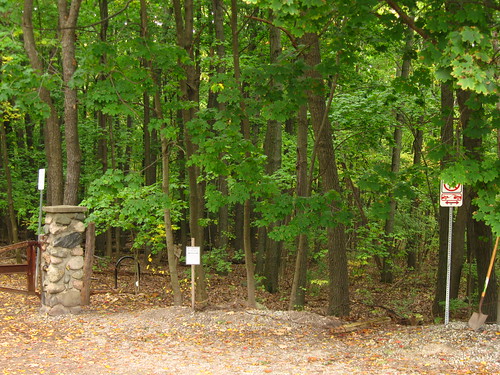
The other day, I went and redug the post holes, and returned the posts to their positions.

Still, I think that the front area should get a decent make-over and upgrade. New fence posts, new cable, fix the gate and the old gateposts, and - while we're at it - replace the fencing along Liberty Road.

The other day, I went and redug the post holes, and returned the posts to their positions.

Still, I think that the front area should get a decent make-over and upgrade. New fence posts, new cable, fix the gate and the old gateposts, and - while we're at it - replace the fencing along Liberty Road.
Photos from SNRE's annual Homecoming Campfire
Last Friday, October 12, 2012, was SNRE's annual Homecoming Campfire, and welcoming back of the class of 1962. It was a good turnout this year, with Beet Box providing the food, and the speed at which the food disappeared is a testament to how awesome it was! (It disappeared so fast that - between all the activities I was doing - I wasn't able to take a photo of the spread!)
Anyway, before the Campfire, there was some additional log-splitting that needed doing:
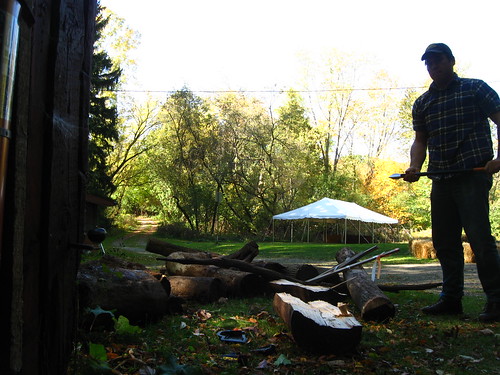
... and I really like that new Fiskars splitting axe that I purchased at the start of the month. It made short work of those ash logs. It's sharp, keeps an great edge, has a perfect wedge for splitting, is well balanced, and is not stupidly heavy.
Prep work also included moving the row boats to a different location:
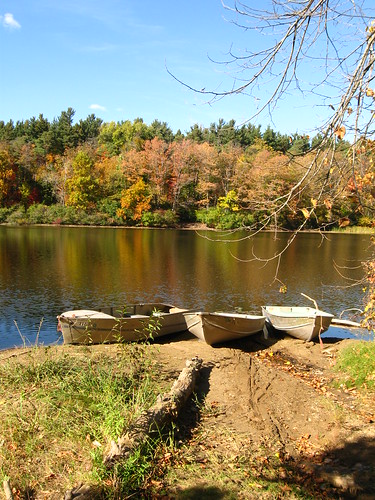
One can't have people taking pleasure rides in the middle of the night, right? And, also, with all the boats there, it makes it difficult to safely run the wader races:
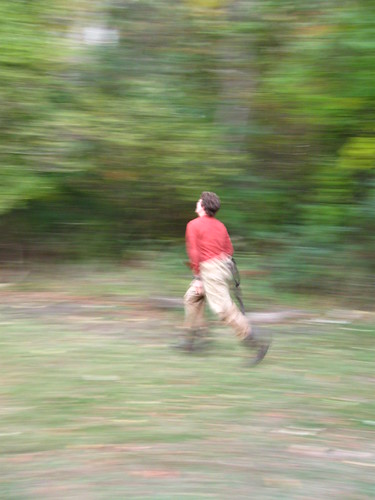
Happily, we were able to run the wader race early enough in the evening that we didn't have to do the log-sawing competition in the dark:

... looking back through my photos, I think that this was the first time in a number of years that the log sawing was done during daylight hours. Usually, it has been illuminated by the headlamps and flashlights of all the cheering SNREds.
It was a great honor of mine to also take the alumni of the class of 1962 on a tour of the forest; a place that they had come many times 50 years previous, when they were forestry students. They asked many interesting questions, were heartened to know that the property was still being used for research and teaching, were a little discouraged about the consequences of the lack of serious investment in the property, and generally curious about what changes I knew of that had happened between the time of their graduation and last Friday. What was meant to be a 40 minute tour of the lake trail turned into a discussion that was more than an hour long about many different aspects of the history and ecology of the forest. Hopefully, SNRE's alumni relations will help in trying to get these former students to recount some of their memories of the forest.
Anyway, before the Campfire, there was some additional log-splitting that needed doing:

... and I really like that new Fiskars splitting axe that I purchased at the start of the month. It made short work of those ash logs. It's sharp, keeps an great edge, has a perfect wedge for splitting, is well balanced, and is not stupidly heavy.
Prep work also included moving the row boats to a different location:

One can't have people taking pleasure rides in the middle of the night, right? And, also, with all the boats there, it makes it difficult to safely run the wader races:

Happily, we were able to run the wader race early enough in the evening that we didn't have to do the log-sawing competition in the dark:

... looking back through my photos, I think that this was the first time in a number of years that the log sawing was done during daylight hours. Usually, it has been illuminated by the headlamps and flashlights of all the cheering SNREds.
It was a great honor of mine to also take the alumni of the class of 1962 on a tour of the forest; a place that they had come many times 50 years previous, when they were forestry students. They asked many interesting questions, were heartened to know that the property was still being used for research and teaching, were a little discouraged about the consequences of the lack of serious investment in the property, and generally curious about what changes I knew of that had happened between the time of their graduation and last Friday. What was meant to be a 40 minute tour of the lake trail turned into a discussion that was more than an hour long about many different aspects of the history and ecology of the forest. Hopefully, SNRE's alumni relations will help in trying to get these former students to recount some of their memories of the forest.
Water collection for 1,4-dioxane sampling
On Monday and Tuesday, water collections were taken throughout Saginaw Forest as part of the yearly audit of 1,4-dioxane contamination levels throughout the property. There was obligatory surface water sample collecting at three locations on Third Sister Lake:

In addition, there was groundwater sample collection at the twelve on-site wells:


In addition, there was groundwater sample collection at the twelve on-site wells:

Just what is that flag barrier for?
Some people might have noticed that there has been a ribbon fence erected in the front yard.

This is to minimize the problems of desire paths. I'd prefer to not have a dirt path carved through the lawn.

This is to minimize the problems of desire paths. I'd prefer to not have a dirt path carved through the lawn.
Tuesday, October 16, 2012
SNREds in the forest
Friday, October 12, 2012
SNRE Campfire Tonight!
This will be the fourth campfire for which I will be the on-the-ground organizer (you know, because I'm the caretaker). The campfire is part of the University of Michigan's School of Natural Resources and Environment's Homecoming celebrations. We're expecting to have a handful of 1962 alumni at the event, in addition to the local alums who are interested in showing up and showing how things are done. Events like this always seem to gel at the last minute (much like a good souffle), but since tonight is the night, I haven't any photos from this year's campfire.
However, this is a photo from my first year as caretaker (2009). That year, the Campfire was on October 1, 2009, and - as you can see - the trees on the far side of the lake hadn't quite turned yet.
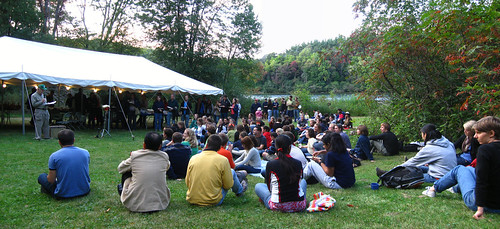
Hopefully, it will be a great Campfire event.
However, this is a photo from my first year as caretaker (2009). That year, the Campfire was on October 1, 2009, and - as you can see - the trees on the far side of the lake hadn't quite turned yet.

Hopefully, it will be a great Campfire event.
Wednesday, October 10, 2012
Peak fall colors
Why does mist rise from the lakes in the morning?
During the fall, there many morning when Third Sister Lake produces gouts of mist and steam:
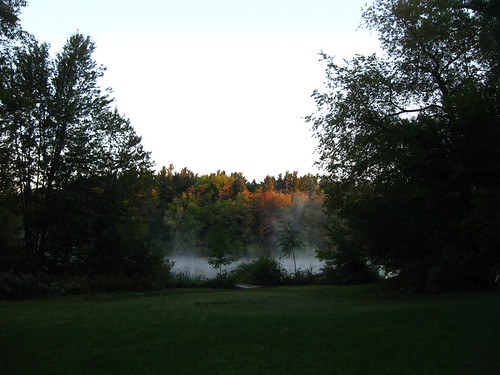
What's going on here? Obviously, the lake is not boiling, and - obviously - there isn't a general fog blanketing the entire forest, so why does the lake look like a pot on the stove? Well, it's due to many of the same principles of what happens when water boils in a pot on the stove, namely evaporation and condensation, but you have to think of these things in terms of heat energy and NOT in terms of water temperature alone.
In the case of boiling water on a stove, water is heated, causing evaporation; the gaseous water requires a certain amount of heat energy to maintain its gaseous state, and if the heat energy of the gaseous water falls below the condensation point, it turns back into liquid water, forming a fine mist. The mist increases in density as the amount of condensing water increases. This is why you see more and more steam rising from a pot of water as it reaches boiling point.
However, it's not only the temperature of the water that you have to consider when thinking about steam formation. In addition to the process of condensation described above, there is also the humidity to consider. In other words, the air itself can only "hold" a certain amount of gaseous water, and this capacity is determined by the temperature of the air; the higher the air temperature, the more water can be held as a gas. This is why there's a lot more steam seen above a pot boiling in very humid conditions than in very dry conditions (even when the air temperatures are identical).
In the case of misty lakes in the morning, all these processes are happening, just like in the example of the boiling pot, except the temperatures are far lower. Throughout the summer, the lake has absorbed and retained a large amount of heat energy in the top layer of the lake. At night -- especially on cloudless nights -- the heat energy in the air rises away from the surface and escapes this local system, thus bringing down the temperature. There is evaporation taking place in the lake, both day and night, thanks to the higher temperatures of the surface of the lake. However, unlike during the heat of the day, at night, since there is a lower temperature, there is less capacity for the air to hold on to gaseous water, and we can measure this as an increase in humidity. As the humidity rises to 100%, the air has a diminishing capacity to hold on to all the water that is evaporating -- due to the heat of the water in the lake -- and so the water almost immediately condenses into mist as it rises from the lake. In fact, if you heat a pot to the same temperature of the lake water, you would see steam flowing up from your pot, even though the water temperature is nowhere near boiling.
Once the sun's rays strike the surface of the water, the humidity is "burned away", in that the local temperature increases enough so that the humidity drops below 100%, thus allowing the air to once again absorb the evaporating water.
Of course, the reason why the lake effectively billows with steam during early fall mornings is due to the relatively large amount of heat stored in the lake combined with one or two significantly cold mornings. The photo above was taken on September 24, 2012, and if we look at the weather conditions measured at the Ann Arbor airport (about five miles away), we see that the overnight temperature dropped to freezing, and the humidity was near saturation. (Of course, this was in an open field, not above a lake, where the saturation would have been 100%.)
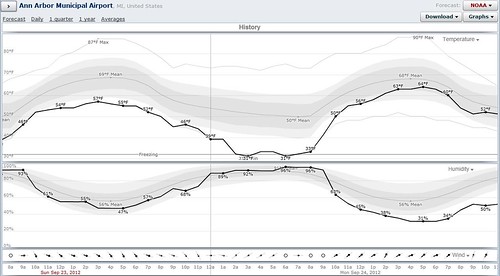
Yeah, okay, so this was a bit of a rambling post, but I hope that it helped you understand (if you didn't already) why so much mist rises off the lake on cool autumnal mornings. Of course, there is little reason to necessarily understand the why in order to appreciate the effect. In the end, fall is a veritable feast of sights, just like spring was one of smells, and summer one of sounds.

What's going on here? Obviously, the lake is not boiling, and - obviously - there isn't a general fog blanketing the entire forest, so why does the lake look like a pot on the stove? Well, it's due to many of the same principles of what happens when water boils in a pot on the stove, namely evaporation and condensation, but you have to think of these things in terms of heat energy and NOT in terms of water temperature alone.
In the case of boiling water on a stove, water is heated, causing evaporation; the gaseous water requires a certain amount of heat energy to maintain its gaseous state, and if the heat energy of the gaseous water falls below the condensation point, it turns back into liquid water, forming a fine mist. The mist increases in density as the amount of condensing water increases. This is why you see more and more steam rising from a pot of water as it reaches boiling point.
However, it's not only the temperature of the water that you have to consider when thinking about steam formation. In addition to the process of condensation described above, there is also the humidity to consider. In other words, the air itself can only "hold" a certain amount of gaseous water, and this capacity is determined by the temperature of the air; the higher the air temperature, the more water can be held as a gas. This is why there's a lot more steam seen above a pot boiling in very humid conditions than in very dry conditions (even when the air temperatures are identical).
In the case of misty lakes in the morning, all these processes are happening, just like in the example of the boiling pot, except the temperatures are far lower. Throughout the summer, the lake has absorbed and retained a large amount of heat energy in the top layer of the lake. At night -- especially on cloudless nights -- the heat energy in the air rises away from the surface and escapes this local system, thus bringing down the temperature. There is evaporation taking place in the lake, both day and night, thanks to the higher temperatures of the surface of the lake. However, unlike during the heat of the day, at night, since there is a lower temperature, there is less capacity for the air to hold on to gaseous water, and we can measure this as an increase in humidity. As the humidity rises to 100%, the air has a diminishing capacity to hold on to all the water that is evaporating -- due to the heat of the water in the lake -- and so the water almost immediately condenses into mist as it rises from the lake. In fact, if you heat a pot to the same temperature of the lake water, you would see steam flowing up from your pot, even though the water temperature is nowhere near boiling.
Once the sun's rays strike the surface of the water, the humidity is "burned away", in that the local temperature increases enough so that the humidity drops below 100%, thus allowing the air to once again absorb the evaporating water.
Of course, the reason why the lake effectively billows with steam during early fall mornings is due to the relatively large amount of heat stored in the lake combined with one or two significantly cold mornings. The photo above was taken on September 24, 2012, and if we look at the weather conditions measured at the Ann Arbor airport (about five miles away), we see that the overnight temperature dropped to freezing, and the humidity was near saturation. (Of course, this was in an open field, not above a lake, where the saturation would have been 100%.)

Yeah, okay, so this was a bit of a rambling post, but I hope that it helped you understand (if you didn't already) why so much mist rises off the lake on cool autumnal mornings. Of course, there is little reason to necessarily understand the why in order to appreciate the effect. In the end, fall is a veritable feast of sights, just like spring was one of smells, and summer one of sounds.
Sunday, October 7, 2012
Fall colors in the forest
Saturday, October 6, 2012
SNRE Campfire is coming...
This coming Friday, October 12, is the SNRE Campfire. This will be the 106th* celebration of the school out in Saginaw Forest, ever since the celebration of "field days" began in 1906.
In preparation for the event, I cleaned up the base of the fire-pit (removing the dirt and grass that had built up over the years),
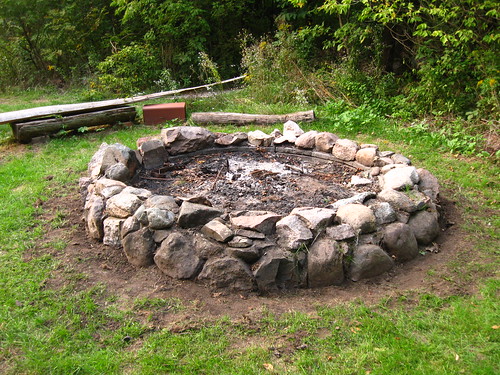
had a lot of the ash wood and pine wood that was lying around brought in,
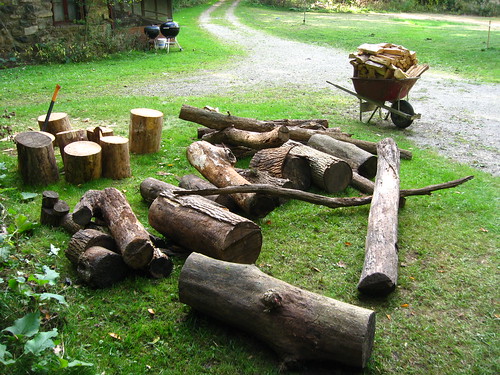
carried over a log for the cross-cut saw competition,

and chopped wood for the campfire.
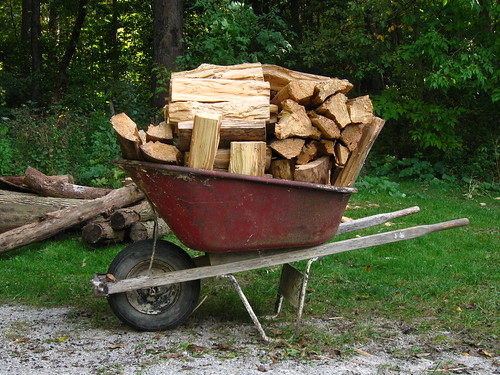
The deliveries of straw bales, pumpkins, event tent & tables, port-a-johns, and trash cans are due to come later in the week.
* I am making the assumption that the School of Forestry continued the tradition during the US involvement in the two World Wars (i.e., 1917-1918 and 1941-1945).
In preparation for the event, I cleaned up the base of the fire-pit (removing the dirt and grass that had built up over the years),

had a lot of the ash wood and pine wood that was lying around brought in,

carried over a log for the cross-cut saw competition,

and chopped wood for the campfire.

The deliveries of straw bales, pumpkins, event tent & tables, port-a-johns, and trash cans are due to come later in the week.
* I am making the assumption that the School of Forestry continued the tradition during the US involvement in the two World Wars (i.e., 1917-1918 and 1941-1945).
Subscribe to:
Posts (Atom)

